上海城隍庙英文介绍 PPT
- 格式:ppt
- 大小:5.72 MB
- 文档页数:20
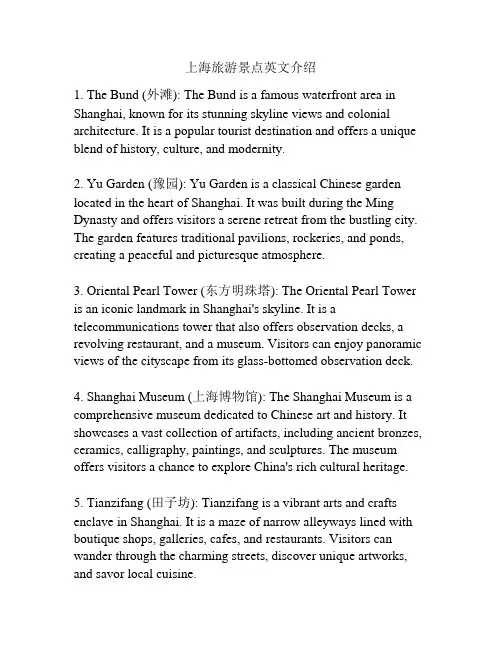
上海旅游景点英文介绍1. The Bund (外滩): The Bund is a famous waterfront area in Shanghai, known for its stunning skyline views and colonial architecture. It is a popular tourist destination and offers a unique blend of history, culture, and modernity.2. Yu Garden (豫园): Yu Garden is a classical Chinese garden located in the heart of Shanghai. It was built during the Ming Dynasty and offers visitors a serene retreat from the bustling city. The garden features traditional pavilions, rockeries, and ponds, creating a peaceful and picturesque atmosphere.3. Oriental Pearl Tower (东方明珠塔): The Oriental Pearl Tower is an iconic landmark in Shanghai's skyline. It is a telecommunications tower that also offers observation decks, a revolving restaurant, and a museum. Visitors can enjoy panoramic views of the cityscape from its glass-bottomed observation deck.4. Shanghai Museum (上海博物馆): The Shanghai Museum is a comprehensive museum dedicated to Chinese art and history. It showcases a vast collection of artifacts, including ancient bronzes, ceramics, calligraphy, paintings, and sculptures. The museum offers visitors a chance to explore China's rich cultural heritage.5. Tianzifang (田子坊): Tianzifang is a vibrant arts and crafts enclave in Shanghai. It is a maze of narrow alleyways lined with boutique shops, galleries, cafes, and restaurants. Visitors can wander through the charming streets, discover unique artworks, and savor local cuisine.6. Nanjing Road (南京路): Nanjing Road is one of Shanghai's busiest shopping streets, offering a wide range of brand-name stores, boutiques, and department stores. It is a great place to experience the energetic atmosphere of the city and to shop for everything from fashion to electronics.7. Jin Mao Tower (金茂大厦): Jin Mao Tower is a skyscraper in Shanghai's Lujiazui financial district. It is one of the tallest buildings in China and offers observation decks with panoramic views of the city. The tower also houses a luxury hotel, offices, and shopping malls.8. Zhujiajiao Water Town (朱家角): Zhujiajiao is a picturesque water town located on the outskirts of Shanghai. It is known for its ancient stone bridges, rivers, and traditional buildings. Visitors can take a boat ride along the canals, explore the narrow streets, and sample local delicacies.9. Shanghai World Financial Center (上海环球金融中心): The Shanghai World Financial Center is a skyscraper with a distinctive trapezoidal opening at the top. It offers observation decks on the 94th, 97th, and 100th floors, providing breathtaking views of the city. The tower also houses offices, hotels, and shopping malls.10. Zhongshan Park (中山公园): Zhongshan Park is a peaceful urban park in Shanghai, named after Sun Yat-sen, the founding father of modern China. It features lush green spaces, beautiful gardens, and a large lake. Visitors can enjoy leisurely walks, picnics, and various recreational activities in the park.。
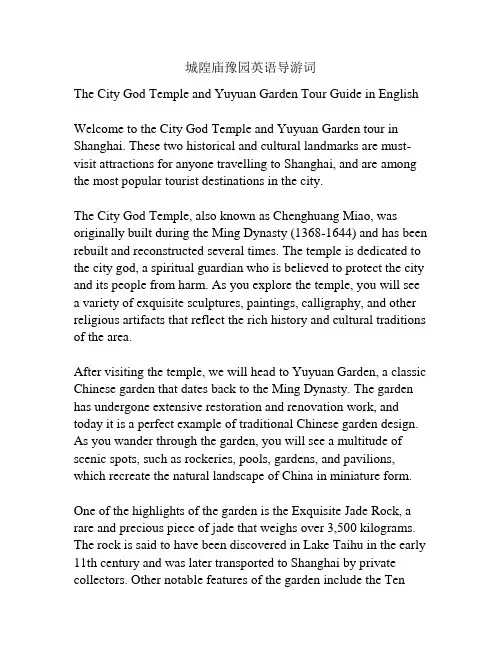
城隍庙豫园英语导游词The City God Temple and Yuyuan Garden Tour Guide in EnglishWelcome to the City God Temple and Yuyuan Garden tour in Shanghai. These two historical and cultural landmarks are must-visit attractions for anyone travelling to Shanghai, and are among the most popular tourist destinations in the city.The City God Temple, also known as Chenghuang Miao, was originally built during the Ming Dynasty (1368-1644) and has been rebuilt and reconstructed several times. The temple is dedicated to the city god, a spiritual guardian who is believed to protect the city and its people from harm. As you explore the temple, you will see a variety of exquisite sculptures, paintings, calligraphy, and other religious artifacts that reflect the rich history and cultural traditions of the area.After visiting the temple, we will head to Yuyuan Garden, a classic Chinese garden that dates back to the Ming Dynasty. The garden has undergone extensive restoration and renovation work, and today it is a perfect example of traditional Chinese garden design. As you wander through the garden, you will see a multitude of scenic spots, such as rockeries, pools, gardens, and pavilions, which recreate the natural landscape of China in miniature form. One of the highlights of the garden is the Exquisite Jade Rock, a rare and precious piece of jade that weighs over 3,500 kilograms. The rock is said to have been discovered in Lake Taihu in the early 11th century and was later transported to Shanghai by private collectors. Other notable features of the garden include the TenThousand Flower Tower, the Zigzag Bridge, and the Mid-Lake Pavilion, each with their unique stories and symbolism.During this tour, our guide will provide you with in-depth information about the history, culture, and significance of these landmarks, and you will have ample opportunities to ask questions and take photos. It's a great way to explore the ancient Chinese culture and get a taste of the old Shanghai charm.Thank you for choosing our tour, and we hope you have a memorable and enjoyable experience at the City God Temple and Yuyuan Garden.Welcome to the City God Temple and Yuyuan Garden tour in Shanghai. These two attractions are perfect for anyone interested in the history and culture of China. They are among the most popular tourist destinations in Shanghai and offer a glimpse into the traditional way of life in China.The City God Temple, also known as Chenghuang Miao, is a historic temple that has been beautifully restored. The temple is dedicated to the city god, who watches over the city and protects it from evil spirits. The temple is home to several deities, including the city god himself. You can take a stroll through the temple and see the various statues, paintings, and calligraphy that tell the story of the gods and their connections to the people of Shanghai.After visiting the temple, we will move on to Yuyuan Garden, a picturesque Chinese garden that has been beautifully preserved for centuries. You can take a leisurely stroll through the garden and enjoy the beauty of the landscape. You will see several stunning features of the garden, such as the Zigzag Bridge, the Nine-BendBridge, and the Mid-Lake Pavilion. These features are designed to represent the natural beauty of China, and you can see how they come together in this stunning garden.One of the main attractions of Yuyuan Garden is the ExquisiteJade Rock, which is a rare and valuable treasure. This rock weighs over 3,000 kg and is said to have been discovered in Lake Taihu over a thousand years ago. The rock has been in private ownership ever since and is now housed in the garden for visitors to see.During this tour, our guide will provide you with detailed information about the history, culture, and significance of these landmarks. You will learn about the gods of the City God Temple and their relationships with the people of Shanghai. You will also learn about the traditional Chinese garden design and how it reflects the beauty of nature. You will have plenty of opportunities to ask questions and take photos.Thank you for choosing our tour, and we hope you have a fantastic experience at the City God Temple and Yuyuan Garden.欢迎参加我们的上海城隍庙和豫园游览。
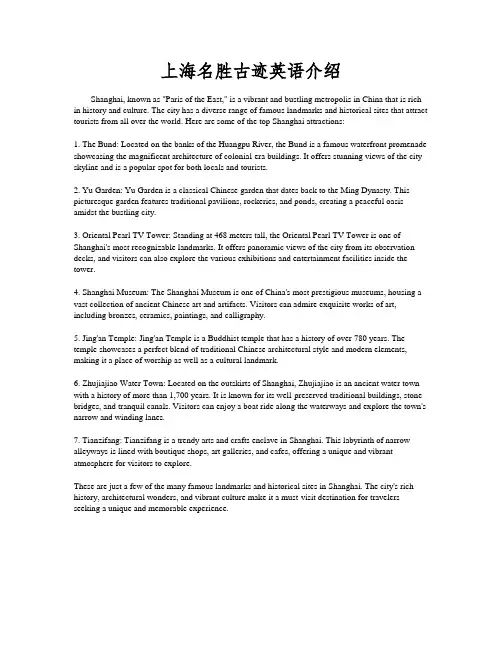
上海名胜古迹英语介绍Shanghai, known as "Paris of the East," is a vibrant and bustling metropolis in China that is rich in history and culture. The city has a diverse range of famous landmarks and historical sites that attract tourists from all over the world. Here are some of the top Shanghai attractions:1. The Bund: Located on the banks of the Huangpu River, the Bund is a famous waterfront promenade showcasing the magnificent architecture of colonial-era buildings. It offers stunning views of the city skyline and is a popular spot for both locals and tourists.2. Yu Garden: Yu Garden is a classical Chinese garden that dates back to the Ming Dynasty. This picturesque garden features traditional pavilions, rockeries, and ponds, creating a peaceful oasis amidst the bustling city.3. Oriental Pearl TV Tower: Standing at 468 meters tall, the Oriental Pearl TV Tower is one of Shanghai's most recognizable landmarks. It offers panoramic views of the city from its observation decks, and visitors can also explore the various exhibitions and entertainment facilities inside the tower.4. Shanghai Museum: The Shanghai Museum is one of China's most prestigious museums, housing a vast collection of ancient Chinese art and artifacts. Visitors can admire exquisite works of art, including bronzes, ceramics, paintings, and calligraphy.5. Jing'an Temple: Jing'an Temple is a Buddhist temple that has a history of over 780 years. The temple showcases a perfect blend of traditional Chinese architectural style and modern elements, making it a place of worship as well as a cultural landmark.6. Zhujiajiao Water Town: Located on the outskirts of Shanghai, Zhujiajiao is an ancient water town with a history of more than 1,700 years. It is known for its well-preserved traditional buildings, stone bridges, and tranquil canals. Visitors can enjoy a boat ride along the waterways and explore the town's narrow and winding lanes.7. Tianzifang: Tianzifang is a trendy arts and crafts enclave in Shanghai. This labyrinth of narrow alleyways is lined with boutique shops, art galleries, and cafes, offering a unique and vibrant atmosphere for visitors to explore.These are just a few of the many famous landmarks and historical sites in Shanghai. The city's rich history, architectural wonders, and vibrant culture make it a must-visit destination for travelers seeking a unique and memorable experience.。
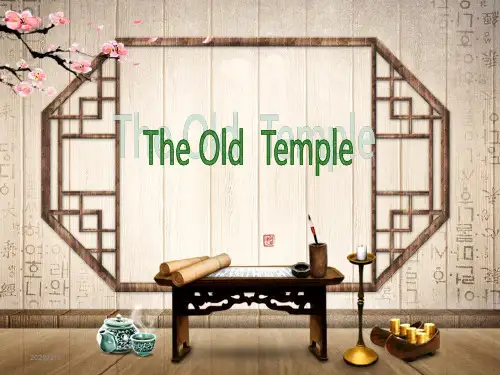
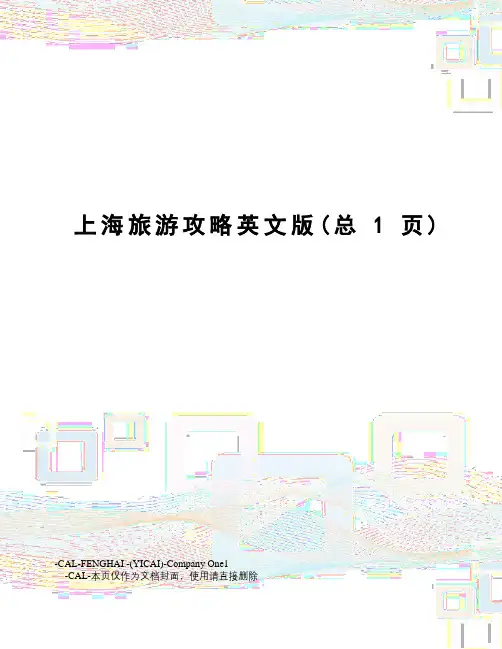
上海旅游攻略英文版(总1页) -CAL-FENGHAI.-(YICAI)-Company One1-CAL-本页仅作为文档封面,使用请直接删除Dear Derke,The following is the Shanghai travel guides and matters needing attention for you,you can as reference :1. Town God's Temple (城隍庙)Shanghai god’s temple, it’s the ancient Chinese palace architecture, Consists of nine palaces .There are a lot of native delicious food, feel the Shanghai local culture . Address: Huangpu district 218 AnRen street or square city road N0. 249. Bus: 11, 42, 64, 66, 64, 945, 911, 926 road, etc. Can be reached.2. Shanghai Bund (外滩)The bund like as a recent history of china, so have to go visit it , Has the sense of history and culture, The Bund has dozens of historical European colonial buildings lining against the Huangpu river that once housed numerous banks from Britain, France, USA, Russia, Germany, Japan, The Netherlands and Belgium.3. The Eastern pearl broadcasts the television tower(东方明珠塔)The Oriental Pearl Tower is a TV tower Shanghai Oriental Pearl Tower is located at the tip of Lujiazui in the Pudong district, by the side of Huangpu River, opposite the Bund of Shanghai. The design of the building is based on a Tang dynasty poem about the haunting sound made by a lute. Transportation: Bus 870, 871, 872, bus 81, 82 road,Tunnel :3, 4, 5, 6 lines,metro line: 2Open time: 8:00am – 9:00pm4, Nanjing road walk street (南京路步行街)Nanjing Road (南京路) is the main shopping street of Shanghai and one of the world's busiest shopping streets.S hanghai is the most lively, the most prosperous commercial street It extends from The Bund to the People's Square.5. Shanghai Global Financial Hub6. World expo venue2。
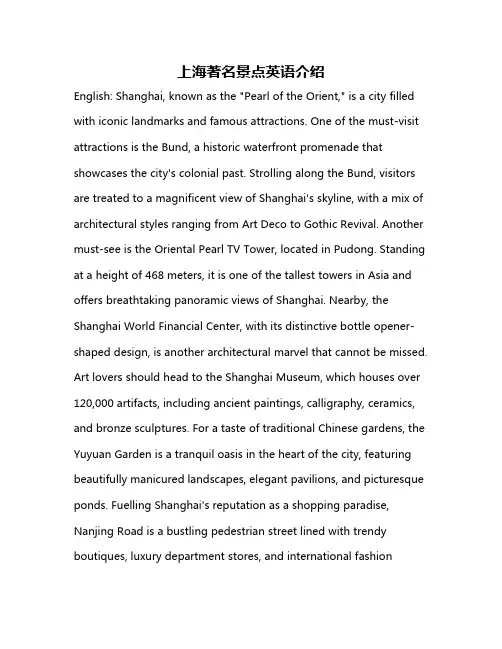
上海著名景点英语介绍English: Shanghai, known as the "Pearl of the Orient," is a city filled with iconic landmarks and famous attractions. One of the must-visit attractions is the Bund, a historic waterfront promenade that showcases the city's colonial past. Strolling along the Bund, visitors are treated to a magnificent view of Shanghai's skyline, with a mix of architectural styles ranging from Art Deco to Gothic Revival. Another must-see is the Oriental Pearl TV Tower, located in Pudong. Standing at a height of 468 meters, it is one of the tallest towers in Asia and offers breathtaking panoramic views of Shanghai. Nearby, the Shanghai World Financial Center, with its distinctive bottle opener-shaped design, is another architectural marvel that cannot be missed. Art lovers should head to the Shanghai Museum, which houses over 120,000 artifacts, including ancient paintings, calligraphy, ceramics, and bronze sculptures. For a taste of traditional Chinese gardens, the Yuyuan Garden is a tranquil oasis in the heart of the city, featuring beautifully manicured landscapes, elegant pavilions, and picturesque ponds. Fuelling Shanghai's reputation as a shopping paradise, Nanjing Road is a bustling pedestrian street lined with trendy boutiques, luxury department stores, and international fashionbrands. For a unique cultural experience, a visit to the Tianzifang district is a must. This labyrinthine network of alleyways is filled with art studios, craft shops, trendy cafes, and local artsy boutiques. Finally, a trip to Shanghai would not be complete without exploring the ancient water town of Zhujiajiao. Just an hour's drive from the city, this charming town is known for its ancient canals, stone bridges, and traditional Ming and Qing Dynasty architecture.中文翻译: 上海被誉为“东方明珠”,这座城市充满了标志性的地标和著名景点。
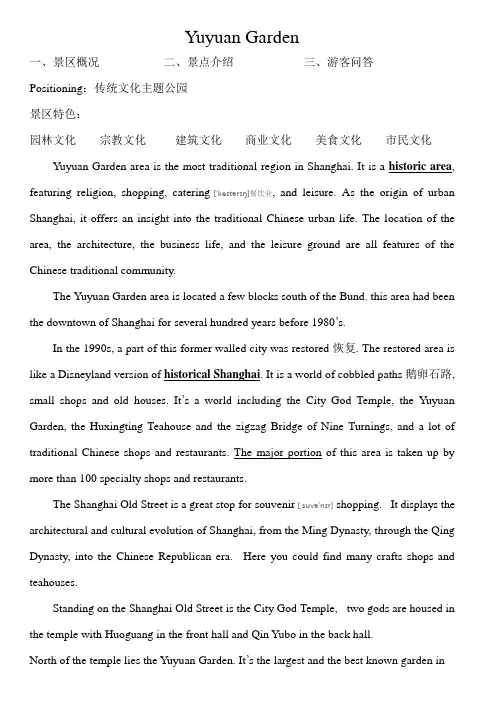
Yuyuan Garden一、景区概况二、景点介绍三、游客问答Positioning:传统文化主题公园景区特色:园林文化宗教文化建筑文化商业文化美食文化市民文化Yuyuan Garden area is the most traditional region in Shanghai. It is a historic area, featuring religion, shopping, catering[ˈkeɪtərɪŋ]餐饮业, and leisure. As the origin of urban Shanghai, it offers an insight into the traditional Chinese urban life. The location of the area, the architecture, the business life, and the leisure ground are all features of the Chinese traditional community.The Yuyuan Garden area is located a few blocks south of the Bund. this area had been the downtown of Shanghai for several hundred years before 1980’s.In the 1990s, a part of this former walled city was restored恢复. The restored area is like a Disneyland version of historical Shanghai. It is a world of cobbled paths鹅卵石路, small shops and old houses. It’s a world including the City God Temple, the Yuyuan Garden, the Huxingting Teahouse and the zigzag Bridge of Nine Turnings, and a lot of traditional Chinese shops and restaurants. The major portion of this area is taken up by more than 100 specialty shops and restaurants.The Shanghai Old Street is a great stop for souvenir[ˌsuvəˈnɪr] shopping.It displays the architectural and cultural evolution of Shanghai, from the Ming Dynasty, through the Qing Dynasty, into the Chinese Republican era.Here you could find many crafts shops and teahouses.Standing on the Shanghai Old Street is the City God Temple,two gods are housed in the temple with Huoguang in the front hall and Qin Yubo in the back hall.North of the temple lies the Y uyuan Garden. It’s the largest and the best known garden inShanghai. It was built in 16th century(1559-1587), by a family named PAN,covering 4 hectares[ˈhɛkˌtɛr]of land.In 18th century, the garden was for sale by Pan family. The transport merchants bought the garden and donated it to the City Temple. The former private garden was then open to the public.Since the 1950s, the garden has become a,apart from modern Shanghai.South of the entrance to the Yuyuan Garden is a lotus pond spanned横跨by a zigzag bridge.The building in the pond is one of the most famous teahouses in China, called Huxinting, or Mid-lake Pavilion.When the local people have holidays , they would habitually come to the Yuyuan Garden for fun. For tourists,A trip to Shanghai is never complete without coming to Yuyuan Garden. Here we are, let me show you the way.(假山)三穗堂与大假山景区(雕塑)梅妻鹤子与铁狮(借景)鱼乐榭+(框景)复廊(院落)万花楼+(雕塑)龙墙(建筑)点春堂景区(景致)会景楼景区(石文化)玉玲珑景区(庙园)内园1、Hall of Three Corn-earsThis is the Hall of Three Corn-ears (We call it San Sui Tang), built in 1760,about 250 years old. It was the place for the owner to entertain his guests and his family.In mid-18th century, the businessmen in rice and bean trade ruined the old hall here, built a new office building, and named Hall of Three Corn-ears, representing their wish for a bumper [ˈbʌmpɚ ]特大harvest. This Hall is decorated with carvings of crops and fruits as well as auspicious [ɔˈspɪʃəs] designs of pines松树and cranes仙鹤.Hall of Three Corn-ears is the grandest in this garden, measuring nine meters high and with five bays隔间. For a while in the Qing Dynasty, this hall had been the meeting place for officials to study imperial e dicts[ˈiˌdɪkt]诏书. Now the hall is furnished as a typical meeting room with a complete set of furniture.Look,In the middle of the hall stands a screen屏风which carries an essay散文on the birth of the garden by its founder, Pan Yunduan.Hung from the ceiling are three plaques [p'lɑ:ks]牌匾. The plaque at the bottom carries the name of this hall. The middle one reads Ling Tai Jing Shi灵台经始, which refers to the first legendary garden in China over 2000 years ago. The plaque on the top reads Cheng Shi Shan Lin城市山林, meaning Mountains and Forests in the City.OK,let’s move on to the next scenery.2、The Grand RockeryYou can see The Grand Rockery here,it is the cream of the Y uyuan Garden, a legacy of Ming Dynasty.Designed by Zhang Nanyang, a famous garden artist of Ming Dynasty, the rockery is created with 2,000 tons of yellow stones.The stones are fused together with a mixture of alum ['æləm]明矾, lime石灰, and rice. This rockery is 60 meters in width,14 meters in height, Close observation would reveal more features of this “High Mountains”. It has piercing peaks, steep cliffs, ravines, caves, rocks, bridges. Winding paths are found threading through trees and bushes,going zigzag up to the top of hill. The water cuts into the hill to form a little stream,flowing down to the pond below. On a rainy day, a little cascade could be seen.On the side of the rockery is a small pavilion亭for a rest stop. Another pavilion on top of the hill is called Pavilion for Viewing the River (Wang Jiang Ting).Circling the rockery at the back is an up-and-down wall起伏的墙topped with a huge dragon. The dragon hides itself behind the hill, so it is called the Reclining(斜躺的)Dragon卧龙.1、The sculpture of Plum Wives and Crane Sons梅妻鹤子L &G,Here is a sculpture in the window frame. You could see a plum tree梅花树anda crane in the sculpture. It is called “Plum Wives and Crane Sons”.The sculpture is associated with a poet of the Song Dynasty by the name of Lin Pu. Lin was a talented poet and a nature lover. He built himself a hut and planted trees and flowers all around. Among all the plants he loved plum trees best. he grew a lot of plum trees, and raised a crane as his companion. P eople said about him as “the poet who loves plum trees as wives,and loves cranes as sons”.When he died,the crane stood in front of his tomb,crying without eating any food,then died with its master. FinalllyLin was buried in the suburb of Hangzhou,people buried the crane next to him.2、The Sculptures of Iron Lions :Now we are arriving at the entrance to the corridor.There are two iron lions stands here. Cast in the Yuan Dynasty, they are 700 years old.These two lions were originally found in front of the government building of Anyang ,in Henan Province. During the Anti-Japanese War they were carried to Tokyo and did not return to China until the end of the war in 1945. After Y uyuan was renovated翻修in 1950s,they were planted here till now.Regarded as the king of animals, lions signi fy “dignity” and “majesty”. Lion sculptures are often found in front of palaces, courts, mansions to show the owner’s power and status.Such sculptures are usually in pairs.The female one is always put to the right while the male one stands on the left. The female lion is often pictured with a baby lion under its paw, the male with a ball. .The female one is always put to the right while the male one stands on the left.But when you stand in front of them,you’ll find The female one is on the left while the male on the right. It depends on which angle you stand.水一水1、Happy Fish Pavilion鱼乐榭L&G, Now we are at Happy Fish Pavilion. It Refers to the main building of this small garden,surrounded by white-washed walls and corridors. You can see The garden is a sample of typical Chinese gardens. The middle of the garden is a stream-like pond, deep and wild荒凉with zigzag rocky banks. One side of the pond are growing some plants with green leaves, and the other sides are vines葡萄藤hanging down into the water. In the corner is a grand wisteria紫藤. It’s over 300-year old.The pavilion you stand is just Happy Fish Pavilion, which offers you a good view of the fish in the pond.Please look, At the far end, the white-washed wall has an opening, the reflections of the scenery on the other side of the wall is borrowed into this garden, creating a larger space than it really is. This is one of great features of Chinese garden: borrowed scenery to make the garden larger.It’s the very imporatance to Chinese garden.The name of the pavilion,Happy Fish, is related to Zhuang Zi. He is one of the founders Chinese religion Daoism, Once upon a time, Zhuang Zi and Hui Zi, stood in front of a pond, some fish were swimming. Zhuang Zi said, “Look, the fish are so happy.” Hui Zi asked, “How do you know they are happy since you are not fish?” Zhuang Zi answered, “How do you know that I do not know they are happy since you are not me?” Then, Hui Zi said “if I cannot know what you know, you cannot know the happiness of the fish”, To that, Z huang Zi answered “When you asked me how I knew the happiness of the fish, you knew that I knew. And I knew it from my own feelings.”This story tells us sometimes you could use your own feeing/senses to feel the world, rather than use your reasoning.2、Double Corridor复廊Next we come to the Double Corridor. It is a zigzag structure with two parallel corridors.Along the corridors the scenery on one side is different from the other side. On the side of the Happy Fish Pavilion, the scenery features lush茂密trees and flowers whichare dynamic动态in a breeze. The other side provides the views of chambers, towers and a houseboat游船, which are all static 静态的viewingsHere you can see many open windows in the corridors.Creating views with frames is another feature widely used in Chinese gardens. The open windows create a variety of views. Walking on one side, these open windows allow you to have a look at the other side in a framed form. They remind you that the scenary is like traditional Chinese painting.They are often in frames. Now every one can see through these open windows and take some photos.1、The Tower of Ten Thousand Flowers 万花楼At the end of the corridor is a separate courtyard[ˈkɔrtˌjɑrd],it’s called Tower of Ten Thousand Flowers.万花楼。
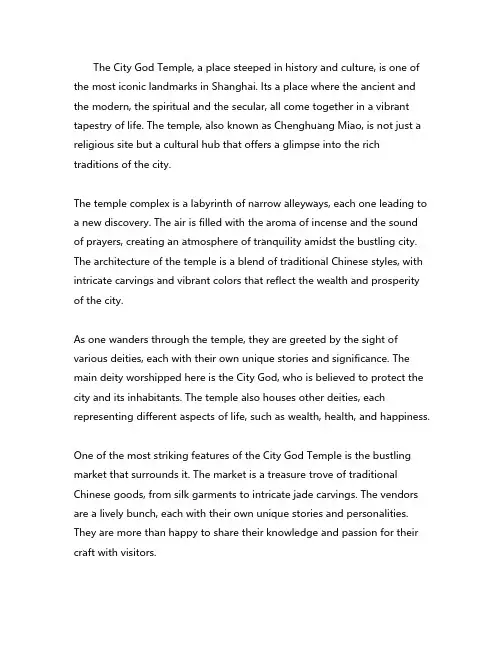
The City God Temple, a place steeped in history and culture, is one of the most iconic landmarks in Shanghai. Its a place where the ancient and the modern, the spiritual and the secular, all come together in a vibrant tapestry of life. The temple, also known as Chenghuang Miao, is not just a religious site but a cultural hub that offers a glimpse into the rich traditions of the city.The temple complex is a labyrinth of narrow alleyways, each one leading to a new discovery. The air is filled with the aroma of incense and the sound of prayers, creating an atmosphere of tranquility amidst the bustling city. The architecture of the temple is a blend of traditional Chinese styles, with intricate carvings and vibrant colors that reflect the wealth and prosperity of the city.As one wanders through the temple, they are greeted by the sight of various deities, each with their own unique stories and significance. The main deity worshipped here is the City God, who is believed to protect the city and its inhabitants. The temple also houses other deities, each representing different aspects of life, such as wealth, health, and happiness.One of the most striking features of the City God Temple is the bustling market that surrounds it. The market is a treasure trove of traditional Chinese goods, from silk garments to intricate jade carvings. The vendors are a lively bunch, each with their own unique stories and personalities. They are more than happy to share their knowledge and passion for their craft with visitors.The City God Temple is not just a place for worship and shopping, but also a place for socializing and entertainment. The temple hosts various festivals and events throughout the year, each one offering a unique experience. During the Chinese New Year, the temple is transformed into a sea of red, with lanterns and decorations adorning every corner. The atmosphere is electric, with firecrackers and dragon dances filling the air.The temple also serves as a place for reflection and contemplation. Many visitors come here to light incense and pray for good fortune and protection. The serene atmosphere of the temple provides a peaceful retreat from the hustle and bustle of the city.In conclusion, the City God Temple is a mustvisit destination for anyone interested in experiencing the rich cultural heritage of Shanghai. It is a place where the past and the present, the sacred and the secular, all come together in a harmonious blend. Whether you are seeking spiritual enlightenment, cultural exploration, or simply a place to soak in the atmosphere, the City God Temple offers something for everyone.城隍庙,一个充满历史和文化的地标,是上海最具标志性的景点之一。

上海旅游攻略英文版(总1页) -CAL-FENGHAI.-(YICAI)-Company One1-CAL-本页仅作为文档封面,使用请直接删除Dear Derke,The following is the Shanghai travel guides and matters needing attention for you,you can as reference :1. Town God's Temple (城隍庙)Shanghai god’s temple, it’s the ancient Chinese palace architecture, Consists of nine palaces .There are a lot of native delicious food, feel the Shanghai local culture . Address: Huangpu district 218 AnRen street or square city road N0. 249. Bus: 11, 42, 64, 66, 64, 945, 911, 926 road, etc. Can be reached.2. Shanghai Bund (外滩)The bund like as a recent history of china, so have to go visit it , Has the sense of history and culture, The Bund has dozens of historical European colonial buildings lining against the Huangpu river that once housed numerous banks from Britain, France, USA, Russia, Germany, Japan, The Netherlands and Belgium.3. The Eastern pearl broadcasts the television tower(东方明珠塔)The Oriental Pearl Tower is a TV tower Shanghai Oriental Pearl Tower is located at the tip of Lujiazui in the Pudong district, by the side of Huangpu River, opposite the Bund of Shanghai. The design of the building is based on a Tang dynasty poem about the haunting sound made by a lute. Transportation: Bus 870, 871, 872, bus 81, 82 road,Tunnel :3, 4, 5, 6 lines,metro line: 2Open time: 8:00am – 9:00pm4, Nanjing road walk street (南京路步行街)Nanjing Road (南京路) is the main shopping street of Shanghai and one of the world's busiest shopping streets.S hanghai is the most lively, the most prosperous commercial street It extends from The Bund to the People's Square.5. Shanghai Global Financial Hub6. World expo venue2。
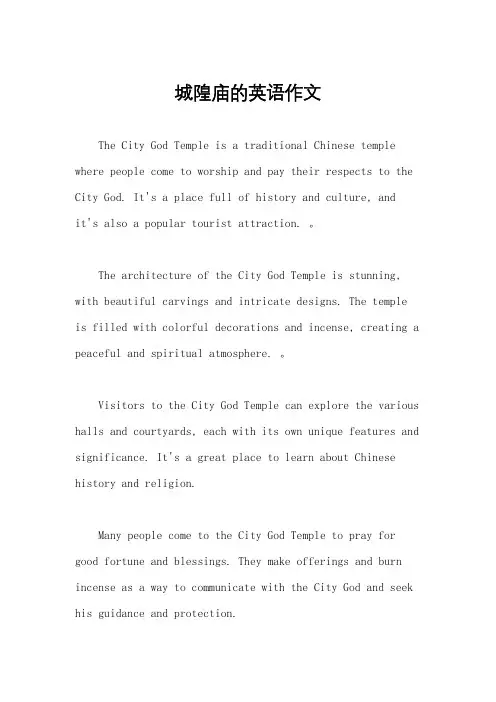
城隍庙的英语作文The City God Temple is a traditional Chinese temple where people come to worship and pay their respects to the City God. It's a place full of history and culture, andit's also a popular tourist attraction. 。
The architecture of the City God Temple is stunning, with beautiful carvings and intricate designs. The templeis filled with colorful decorations and incense, creating a peaceful and spiritual atmosphere. 。
Visitors to the City God Temple can explore the various halls and courtyards, each with its own unique features and significance. It's a great place to learn about Chinese history and religion.Many people come to the City God Temple to pray for good fortune and blessings. They make offerings and burn incense as a way to communicate with the City God and seek his guidance and protection.The City God Temple is not just a place for worship,but also a center for cultural activities and events. Traditional performances and ceremonies are often held here, attracting both locals and tourists alike.Overall, the City God Temple is a must-visitdestination for anyone interested in Chinese culture and history. It's a place of beauty, spirituality, andtradition, and it offers a unique glimpse into the rich heritage of China.。

城隍庙美食英文介绍作文Walking into the City God Temple, the first thing that catches your eye is the array of delicious street food stalls lining the entrance. From steaming hot dumplings to crispy fried chicken, the aroma of sizzling woks and savory spices fills the air, tempting your taste buds with every step.As you make your way through the bustling temple grounds, you'll come across a variety of traditional Chinese snacks and desserts. One must-try is the tangyuan, sweet glutinous rice balls filled with black sesame or red bean paste, served in a fragrant ginger syrup. The chewy texture and rich, nutty flavor make it a popular choice among locals and tourists alike.For those craving something heartier, the temple also offers a selection of savory dishes such as braised pork belly, stir-fried noodles, and tender beef skewers. Each dish is bursting with bold flavors and fresh ingredients,reflecting the rich culinary heritage of the region.If you're in the mood for a refreshing drink, be sure to sample the freshly squeezed fruit juices and herbal teas available at the temple. From zesty citrus blends to soothing jasmine infusions, there's a beverage to suit every palate and provide a welcome respite from the summer heat.As you indulge in the delectable treats at the City God Temple, take a moment to soak in the vibrant atmosphere and observe the locals going about their daily rituals. Whether you're savoring a piping hot bowl of noodles or sipping on a cool, fruity beverage, the temple's food scene offers a true taste of Shanghai's culinary delights.。
城隍庙的英语作文The City God Temple。
The City God Temple, also known as Chenghuang Temple,is a popular tourist attraction in China. It is a Taoist temple dedicated to the City God, who is believed toprotect the city and its people. The temple is usually located in the center of the city, and it is a place where people come to pray for good luck and fortune.The history of the City God Temple can be traced back to the Tang Dynasty (618-907). It was originally built as a place to worship the gods of the land and the grain, but later it was dedicated to the City God. The temple has been rebuilt and renovated many times over the centuries, and it has become a symbol of the city's culture and history.The City God Temple is a magnificent building with a traditional Chinese architectural style. It has a large courtyard with a main hall, side halls, and a bell tower.The main hall is where the statue of the City God is enshrined, and it is surrounded by other statues of godsand goddesses. The side halls are used for various purposes, such as worshipping the god of wealth, the god of marriage, and the god of education. The bell tower is where thetemple's bell is located, and it is rung to signal the opening and closing of the temple.The City God Temple is not only a place of worship but also a cultural center. It hosts various events andactivities throughout the year, such as traditional Chinese festivals, calligraphy exhibitions, and folk art performances. Visitors can also enjoy the local cuisine and buy souvenirs at the temple's shops.In addition to its cultural significance, the City God Temple is also a popular tourist destination. It attracts millions of visitors from all over the world every year, who come to admire its beauty and learn about the city's history and culture. The temple is a must-see attractionfor anyone visiting China, and it is a testament to the country's rich cultural heritage.In conclusion, the City God Temple is a significantpart of China's cultural heritage and a symbol of thecity's history. It is a place of worship, a cultural center, and a popular tourist attraction. Its magnificent architecture, beautiful surroundings, and rich history make it a must-visit destination for anyone interested in Chinese culture and history.。
城隍庙灯会英文作文英文回答:The City God Temple Lantern Festival is an annual festival held in Shanghai, China, during the Spring Festival. It is one of the most popular and iconicfestivals in the city, attracting millions of visitors each year.The festival features a variety of activities,including traditional Chinese music and dance performances, lantern displays, and food stalls. The highlight of the festival is the lantern display, which features thousands of lanterns of all shapes and sizes. The lanterns are lit up at night, creating a beautiful and festive atmosphere.One of the most popular areas of the festival is the Yuyuan Garden, which is decorated with thousands of lanterns. Visitors can also enjoy the many shops and restaurants in the garden.Another popular area of the festival is the Bund, which is a waterfront promenade along the Huangpu River. Visitors can enjoy the lantern displays as well as the views of the city.The City God Temple Lantern Festival is a wonderful opportunity to experience Chinese culture and traditions.It is a great way to celebrate the Spring Festival and to enjoy the beauty of Shanghai.中文回答:城隍庙灯会是上海一年一度的传统节日,于春节期间举行,是上海最受欢迎、最具代表性的节日之一,每年吸引数百万游客。
城隍庙英语作文The City God Temple is a famous traditional Chinese temple, which can be found in many cities in China. It is a place where people go to pray for good luck, health, and prosperity. The City God Temple is not only a religious site, but also a cultural and historical landmark that attracts tourists from all over the world.The City God Temple is usually located in the center of the city, and it is surrounded by a bustling market, where visitors can buy traditional Chinese handicrafts, souvenirs, and local snacks. The temple itself is a beautiful and serene place, with traditional Chinese architecture, red walls, and golden roofs. As you enter the temple, you will be greeted by the smell of burning incense and the sound of Buddhist chants.The main hall of the City God Temple is dedicated tothe City God, who is believed to protect the city and its people. People come to the temple to pray to the City Godfor blessings and good fortune. They light incense sticks, make offerings, and kneel in front of the statue of the City God, praying for their wishes to come true.Apart from the main hall, the City God Temple also has other halls and pavilions dedicated to different gods and goddesses. There are also beautiful gardens and ponds where visitors can relax and enjoy the peaceful atmosphere. The temple is a great place to learn about Chinese culture and history, as there are often exhibitions and performances that showcase traditional Chinese art and customs.The City God Temple is not only a religious andcultural site, but also a popular tourist destination. Every year, millions of people from all over the world come to visit the temple and experience the rich history and traditions of China. The temple is especially crowded during traditional Chinese festivals, such as the Chinese New Year and the Mid-Autumn Festival, when there are special performances and events held at the temple.In conclusion, the City God Temple is a must-visitdestination for anyone who wants to experience the rich culture and history of China. It is a place of worship, a cultural landmark, and a popular tourist attraction all rolled into one. Whether you are interested in religion, history, or simply want to experience the beauty of traditional Chinese architecture, the City God Temple has something to offer for everyone. So, next time you visit China, make sure to include the City God Temple in your itinerary!。
城隍庙的由来英语作文The origin of Chenghuang Temple can be traced back to ancient China. It was built to worship the City God, who was believed to protect the city and its people from disasters and evil spirits. People would come to the temple to pray for good fortune and seek justice for any wrongs they had suffered.The temple was often located in the center of the city, surrounded by bustling markets and lively streets. It served as a spiritual and cultural center for the local community, where people could gather for religious ceremonies, festivals, and other social activities.Over time, the temple became not only a place of worship, but also a symbol of the city's history and heritage. It was often adorned with intricate carvings, colorful paintings, and beautiful sculptures, reflecting the artistic and architectural styles of the region.As the city grew and changed, so did the temple. It underwent numerous renovations and expansions, evolvinginto a grand and majestic structure that stood as a testament to the city's prosperity and vitality.Today, Chenghuang Temple continues to attract visitors from all over the world, who come to admire its beauty, learn about its history, and experience the rich culture and traditions it represents. It remains a place of reverence and celebration, embodying the enduring spirit of the city and its people.。
Title: My Favorite Place: Chenghuang TempleIn the heart of Shanghai, a place that encapsulates the city's rich history, culture, and spirituality stands proudly - the Chenghuang Temple. This is my favorite destination in the bustling city, a place where I can find tranquility, learn about my cultural roots, and enjoy the beauty of traditional Chinese architecture.The Chenghuang Temple, dedicated to the God of the City, is not just a religious shrine; it's a cultural icon that dates back to the Ming Dynasty. The intricate carvings, vibrant paintings, and elaborate roof tiles reflect the intricate details and craftsmanship of ancient Chinese architects. Walking through the temple's gates, I am transported to a different era, where I can almost hear the whispers of history and the prayers of the faithful.What makes this temple even more enchanting is the bustling market that surrounds it. Vendors sell traditional snacks, such as xiaolongbao and soup dumplings, while others offer handicrafts and souvenirs. The scent of fresh food and the sounds of lively conversation create a vibrant atmosphere that is unique to this place.However, it's not just the architecture or the market that draws me to Chenghuang Temple. It's the sense of community and spirituality that I feel here. The temple is a place where people come together to pray, seek guidance, and celebrate their cultural heritage. The atmosphere is both serene and uplifting, providing a welcome respite from the hustle and bustle of modern life.In conclusion, Chenghuang Temple is not just a tourist attraction; it's a cherished part of my cultural identity. It represents my heritage, my roots, and my connection to the past. Every time I visit, I am reminded of the beauty and depth of Chinese culture, and I am grateful to have such a remarkable place to call my favorite.。
The City God Temple,also known as Chenghuang Temple,is a sacred place in Chinese culture that holds significant historical and religious importance.It is dedicated to the city god,who is believed to be the protector of the city and its inhabitants.Heres a detailed English composition about the City God Temple:The City God Temple is a place of profound cultural and religious significance in China. It is a temple where the city god,a deity believed to watch over the wellbeing of a city and its people,is worshipped and revered.The temple is not just a place of worship but also a symbol of the communitys collective faith and the embodiment of traditional Chinese beliefs.Historical SignificanceThe City God Temple has a rich history that dates back to ancient times.It is believed that the first temple was established during the Tang Dynasty,serving as a spiritual sanctuary for the people.Over the centuries,the temple has undergone numerous renovations and expansions,reflecting the evolving needs of the community and the citys growth.Architectural FeaturesThe architectural style of the City God Temple is a blend of traditional Chinese elements with regional influences.The temple complex is typically characterized by its grand gates, intricately carved wooden structures,and beautifully painted murals depicting scenes from Chinese mythology and history.The main hall,where the statue of the city god is enshrined,is a marvel of craftsmanship,showcasing the skill of ancient artisans. Religious PracticesWorship at the City God Temple is an integral part of the local communitys religious life. Devotees visit the temple to offer prayers,light incense,and seek blessings for the citys prosperity and their personal wellbeing.Festivals and celebrations,such as the Lantern Festival and the MidAutumn Festival,are marked with special ceremonies at the temple, attracting large crowds of both locals and tourists.Cultural ImpactThe City God Temple has had a lasting impact on the cultural landscape of the city.It hasserved as a center for community gatherings,religious ceremonies,and cultural events. The temples influence extends beyond its walls,shaping the citys identity and fostering a sense of unity among its residents.Preservation and Modern SignificanceIn recent years,there has been a concerted effort to preserve and restore the City God Temple to its former glory.This has included the conservation of ancient artifacts,the restoration of architectural elements,and the promotion of cultural events.The temple now stands as a testament to the citys rich heritage and a beacon for cultural preservation. ConclusionThe City God Temple is more than just a place of worship it is a living monument to Chinas cultural and religious history.It continues to play a vital role in the spiritual and social life of the community,offering a glimpse into the past while remaining relevant in the present.Visiting the temple is an enriching experience,providing insights into the deeprooted traditions and beliefs that have shaped the Chinese civilization.This composition provides a comprehensive overview of the City God Temple, highlighting its historical significance,architectural features,religious practices,cultural impact,and modern significance in the preservation of Chinese heritage.。